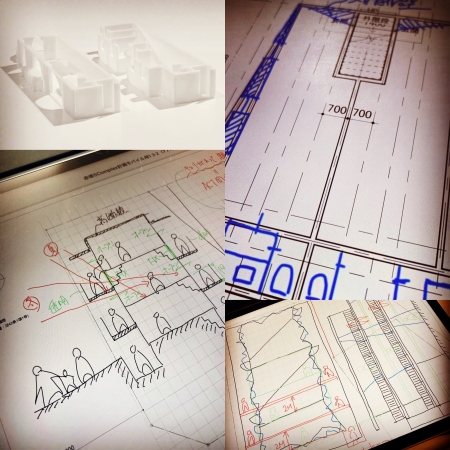ルールをカスタマイズする
汎用性のあるルールをつくり、それを可視化すること、それが設計であり、デザインであるとした場合、整合性をとるためにルールは出現した建築によってカスタマイズされ、またさらに新たに出現した建築によりカスタマイズされることを繰り返さない建築はとても傲慢で嫌らしく見える。
それは、それさえすればいいというのが滲み出ており、それはつまらなく、新鮮さに欠ける。それは自身のスタイルを持つこととは正反対で、むしろ没個性へとつながる。
設計に正解を求めるようなことを意識的にしたことはないが、集合住宅の計画をしていると無意識に正解を探しているような気になる時があり、その都度改めようとする。集合住宅の効率性や集積性を意識すると、建築計画上、そこに正解が漂っているかの如く錯覚を起こしてしまい、そこから今度は外れようとすると、効率性や集積性が蔑ろになり、それに違和感を覚える。
汎用性のあるルールは、一般的に共通理解がある枠組み、例えば、集合住宅の効率性や集積性、の上に成り立つことになると考えているが、そうすると、それを可視化した場合、その集合住宅の効率性や集積性が邪魔になることがあるかもしれないと考えられる。
だから、設計のプロセスで架空の建築を立ち上げ、ルールをカスタマイズすることを繰り返してみようと考えている。
"Customize rules"
Creating a versatile rule and visualizing it, if it is a design and a design, the rule is customized by the emerging architecture for consistency, and also by the newly emerging architecture Architecture that is not repeatedly customized looks very arrogant and disgusting.
It's exuding that all you have to do is that it's boring and lacking in freshness. It's the opposite of having your own style, but rather leads to personality.
I have never consciously asked for the correct answer in the design, but when I am planning an apartment house, I sometimes feel like I am unconsciously searching for the correct answer, and I try to change it each time. If you are conscious of the efficiency and agglomeration of an apartment house, you will get the illusion that there is a correct answer in the architectural plan, and if you try to deviate from it this time, the efficiency and agglomeration will be despised. It makes me feel uncomfortable.
We believe that versatile rules will generally be built on a framework that has a common understanding, such as the efficiency and agglomeration of apartments, but then, when visualized, that apartment. It is thought that the efficiency and agglomeration of the house may be an obstacle.
That's why I'm thinking of launching a fictitious building in the design process and repeating customizing the rules.


